"The History of the Noble King Alexander, King of Macedon"

And they seal it on all sides with lead.
Tsar Alexander entered there with two comrades,
And the sailors go out to the open sea.
(The king) orders the people to lower him (into the sea).
And when the barrel was lowered there,
The lamps burning there made it very light.
The fish looked attentively at the barrel,
Even the bravest were scared
A great light to which they are unaccustomed.
Alexander the Tsar saw them well
And I saw big fish fighting with little ones;
When the little one is captured, it is immediately eaten.
When Alexander saw this, he then decided
That this whole world is lost and damned.
"The Romance of Alexander"
(Translation from Old French by Marina Lushchenko)
Documents stories. It’s autumn now, everything around is gray and dull, especially in the city, where the leaves have already all fallen. I want something bright, colorful, and what could be brighter and more colorful than medieval miniatures from manuscripts.
We have already shown our readers here on VO many times miniatures from various medieval books. However, almost all of them, with rare exceptions, had one big drawback: they were still quite famous, whether it concerns the “Chronicles of Froissart” or the same “Magnificent Book of Hours of the Duke of Berry”. But there are thousands, tens of thousands of illustrated manuscripts, and among them the book of the same content is often designed in completely different ways.
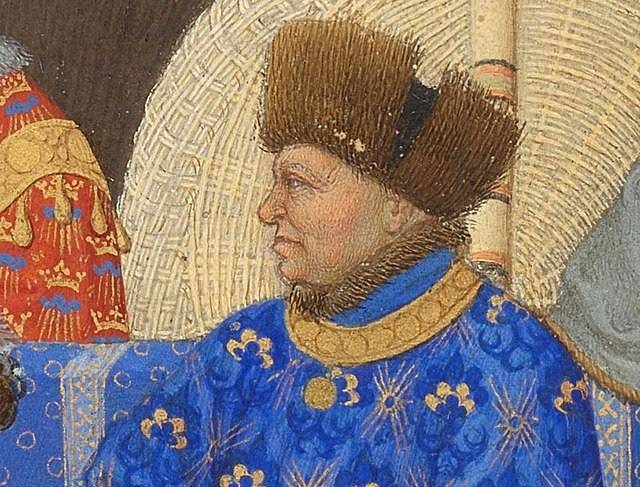
Image of John (Jean), Duke of Berry. Miniature image from The Magnificent Book of Hours of the Duke of Berry. Brothers Limburg, between 1412 and 1416
Take for example the library of the same Duke Jean of Berry (1360–1416), who was the third son of King John II of France and Bonne of Luxembourg. He was a man of interesting fate, who fought, and was held captive as a hostage, and was a diplomat, gained fame, but not on the battlefield, and not as a diplomat, and not even as a royal heir, who never became king . No, already in his time he became famous as a passionate collector and philanthropist.
He received a fairly good education as a child, and he apparently became addicted to reading books under the influence of his father. He bought books wherever possible, and not only bought them, he ordered copies of them from the most famous masters of that time. So after his death, as many as three hundred volumes were counted in the Duke’s library. For that time it was a very large, and most importantly, extremely expensive collection of books.
According to experts, this collection of books by Jean of Berry, even if inferior to the library of Charles V, which had about a thousand volumes, had no equal in terms of artistic design.
However, it cannot be said that the Duke was primarily interested in illuminated manuscripts. He also read the texts of books, since in his collection there are many books without miniatures at all.
Currently, the library of the Duke of Berry is located in the Chantilly Museum, but some of the books that belonged to him are kept in other places.
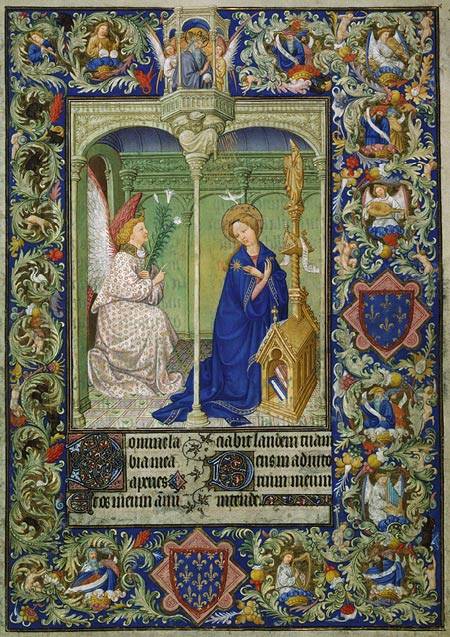
Page “The Annunciation” from the Book of Hours by Jean of Berry. Paul, Jean and Herman de Limburg (Franco-Dutch, active in France 1399–1416) Metropolitan Museum of Art, New York
The collection of his books of religious content is especially valuable. Perhaps it was not only the most numerous, but also the most exquisite in its design.
It is not for nothing that the Duke was nicknamed the “King of Books of Hours.” After all, it was precisely by his order, under his supervision, that such world-famous manuscripts were created: “The Small Book of Hours” (National Library, Paris), the Brussels or Most Beautiful Book of Hours (Royal Library in Brussels), “The Beautiful Book of Hours of Our Lady”, “The Great Book of Hours” "(National Library, Paris), "Beautiful Book of Hours" (Metropolitan Museum, New York) and finally the most beautiful and impressive - Magnificent or Luxurious Book of Hours ("Magnificent Book of Hours of the Duke of Berry").
Moreover, the artists worked on these books for the Duke for many years. There were wars, cities were burning, people were hiding in the forests in fear, complete anarchy reigned in the country (Joan of Arc had not yet appeared). And they still drew and painted miniatures, and even replaced each other, while mastering new artistic movements and improving their skills. They knew about the Duke's demanding taste and his discerning eye and tried their best!
But in the end, humanity received a wonderful contribution to the development of the fine arts of the Middle Ages, and we are all books, the miniatures of which still delight us.
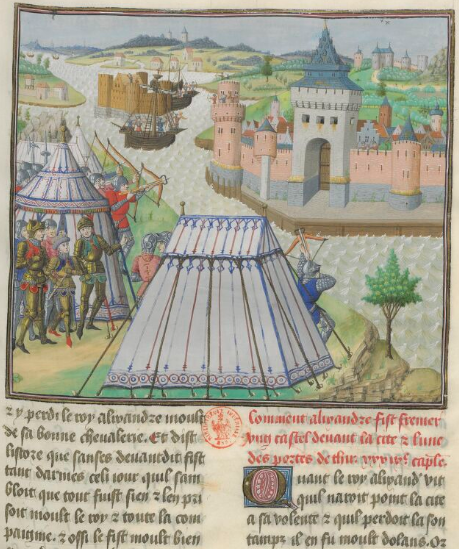
So let's look at the miniatures from the book "History of Alexander", a manuscript made "by order of Jean of Burgundy, Duke of Berry, Count of Estampes." Here is one of the first: Alexander’s soldiers are besieging a city surrounded by a river. In the foreground is a tent and warriors, with knights in “yellow”, that is, gilded armor, but ordinary riflemen, although they wear armor on their legs, are dressed in brigandines, that is, fabric jackets lined with metal plates
However, we have listed above only a few books (albeit the most famous) from the Duke's library. What about the rest hundreds his books, most of which are illuminated, that is, they contain illustrations that are often not inferior in their beauty (and, let us add, information value) to miniatures from world-famous manuscripts.
Fortunately for us, today almost all of these books are digitized and available for reading in electronic form. It is clear that for this you need to know the French language of that time, and know it well.
But... otherwise, other knowledge is quite enough for us. For example, we generally imagine what it looked like weapon and the armor of warriors from the early XNUMXth century, not to mention the fact that some of them have survived to this day. However, the more sources tied to dates known to us, the better. This allows us to recognize their appearance with greater accuracy, compare them with miniatures by other authors, and compare the similarities and differences that exist.
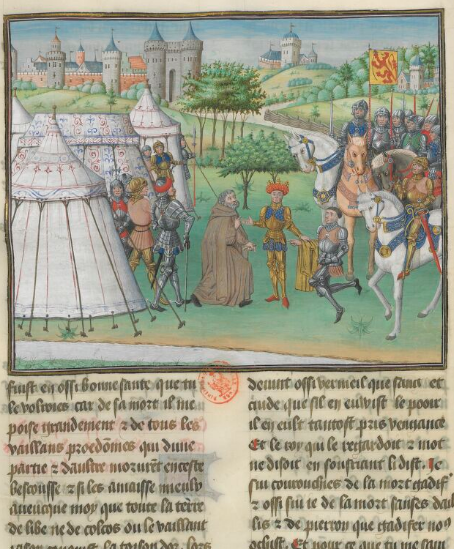
Very informative illustration. The armor is beautifully designed. And this is what becomes clear from this miniature: at the time the illustrations were drawn, the battlefield was dominated by typical Gothic armor with cuirass, consisting of two parts - upper and lower. And the top one was often either not worn at all, or... covered with fabric. For example, brocade woven with golden lilies!
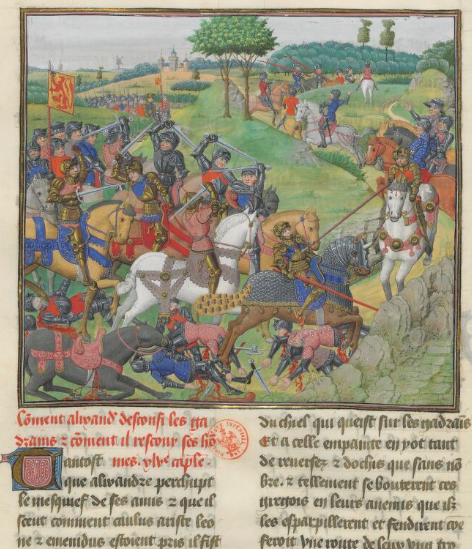
Battle! The horse equipment of those years is very well shown here, and what is especially interesting: a single chainmail blanket with a plate collar and a mask. After all, what was it worth to draw them for all the warriors? But that obviously wasn’t the case, which is what the illustrator tried to emphasize.
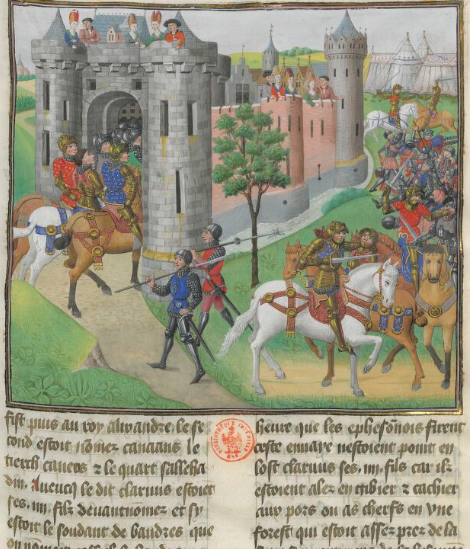
Here we, again, see gilded armor and brigandines on the infantrymen
In previous articles devoted to the topic of book miniatures as sources on the military history of the Middle Ages, we have more than once drawn the attention of VO readers to certain details that miniaturists depicted in them. So today we take a look at the pages of one of the books from the collection of the Duke of Berry. This is the History of the Noble King Alexander, King of Macedon, a translation of the History of Alexander, a manuscript commissioned by John of Burgundy, Duke of Berry, Count of Estampes. National Library of France. Manuscripts Department. No. 9342.
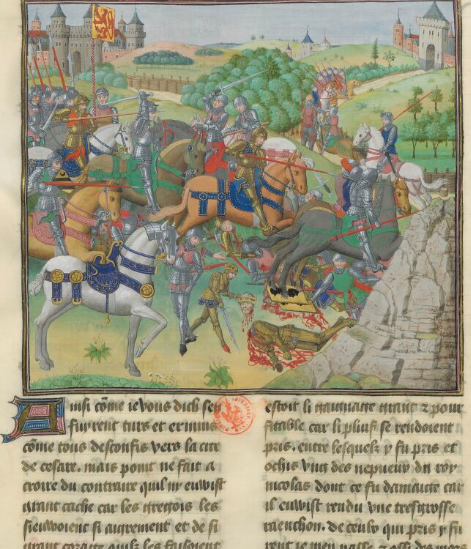
On the left is a horse wearing a forehead mask, whose neck is covered with only two plates. Did his owner not have enough money to cover his entire neck? However, other riders don’t even have this!
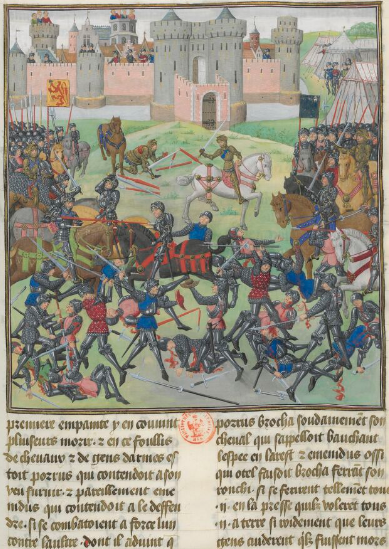
The battle of foot soldiers is depicted very realistically!
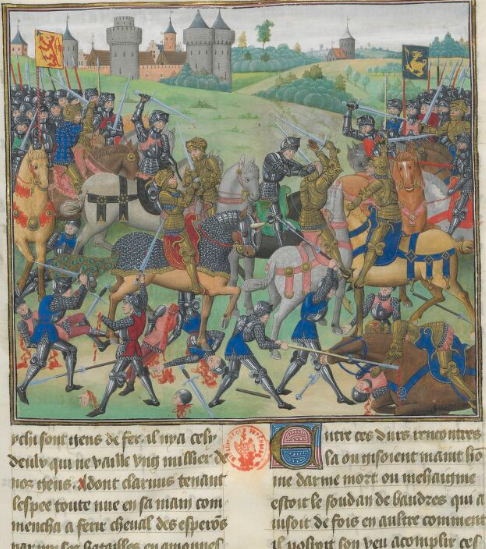
Here again we see a horse in a chain mail blanket, and also... that it was possible to attack the knight even from behind, grab him by the head and... By the way, in all the illustrations we see triangular piercing swords, although those fighting with them also deliver slashing blows
It is clear that this book is nothing more than... a “collection of fairy tales for adults,” something like modern fantasy on a historical theme. But we must not forget that the artists of that time completely lacked historical thinking, and they painted the past as the life that surrounded them at that time. And this is where they couldn’t fantasize, because to distort reality meant “lying in writing,” and this was a terrible sin before God.
It was possible to draw an elephant on soft paws. After all, the illustrator himself did not see it, but drew it from someone else’s words, and if so, then the sin was on the one who told it inaccurately, and not at all on the one who depicted it inaccurately, and the people of the Middle Ages understood this very well...
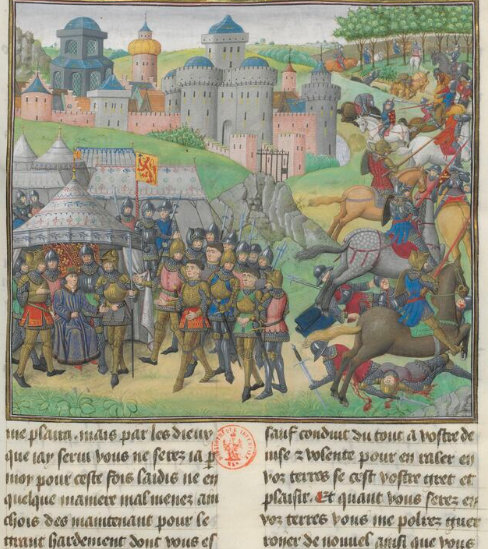
Here they are - all types of knightly armor of the early XNUMXth century!
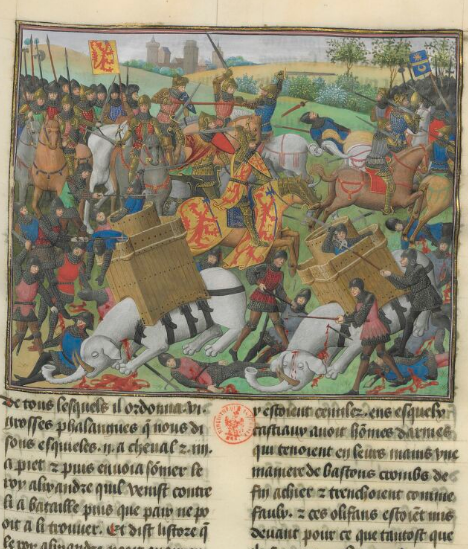
Elephant fight! The way they were described to the artist is how he depicted them! But a knight in a surcoat and on a horse in a heraldic blanket is already a clear anachronism. Only he is depicted in such attire
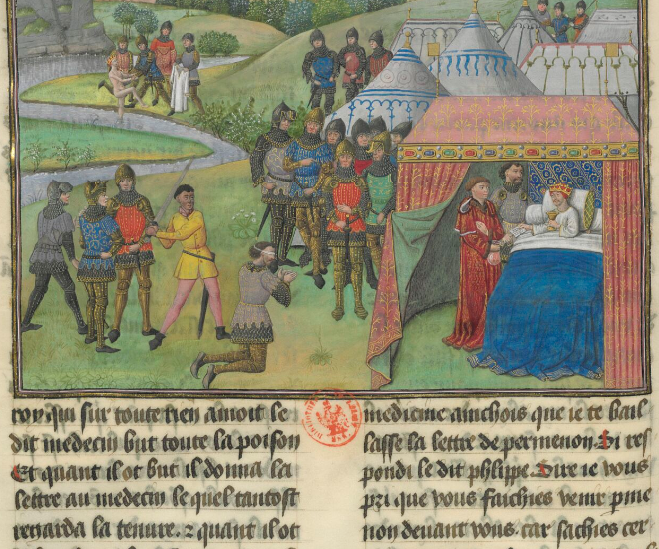
Well, then they executed me like this!
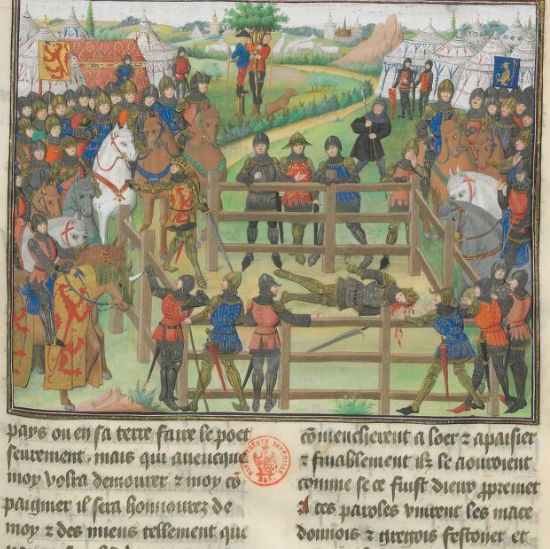
Perhaps this is a scene of “God’s judgment”, because no one comes to the aid of the defeated man
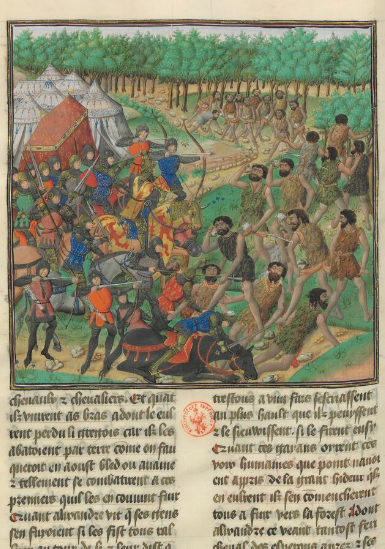
Alexander's warriors fight wild men
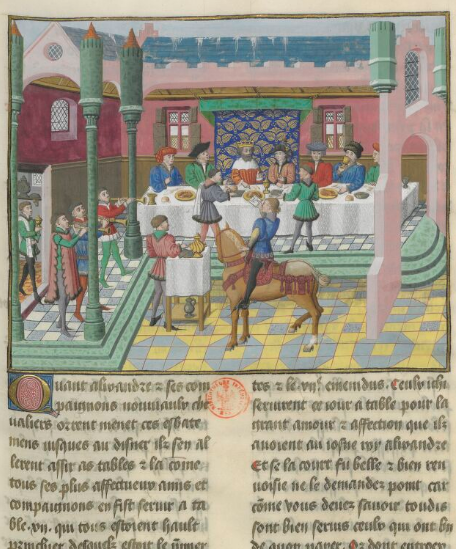
A very beautiful miniature with a feast scene, which the author has never seen anywhere before. True, it would be a mistake to insert it into a new history textbook for the 6th grade, since it would have to explain what a rider on a horse is doing there...
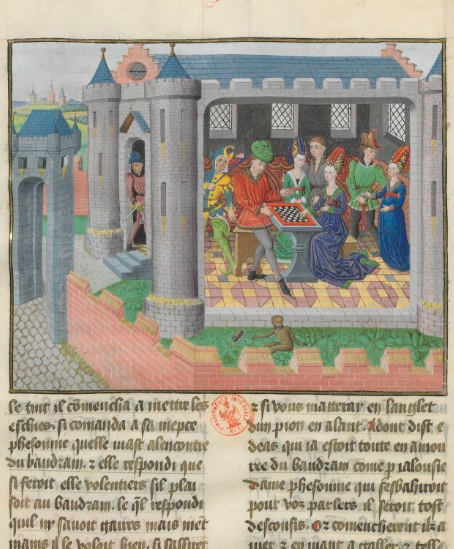
A wonderful scene of medieval leisure time for the nobility. All the costumes, both men's and women's, are perfectly designed. There is a jester busy playing some kind of musical instrument, and a monkey is frolicking on the lawn
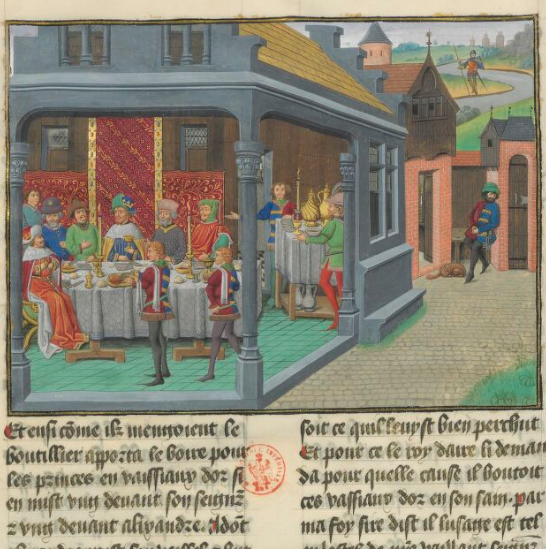
Feast scene. Livery servants or pages bring food into the hall
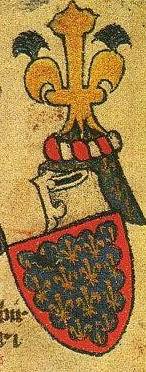
But this coat of arms stands at the end of all the books from the library of Duke Jean of Berry...
Information